Wesleyan University
Wesleyan University (/ˈwɛsliən/ (![]()
 | |
| Latin: Universitas Wesleiana | |
| Type | Private |
|---|---|
| Established | 1831 |
| Endowment | $1.08 billion (2019)[1] |
| President | Michael S. Roth |
| Provost | Robert Rosenthal (interim) |
Academic staff | 430 (Fall 2019)[2] |
| Students | 3,230 (Fall 2019)[3] |
| Undergraduates | 3,018 (Fall 2019)[3] |
| Postgraduates | 212 (Fall 2019)[3] |
| Location | , , United States |
| Campus | Small city, 360 acres (1.5 km2) |
| Student newspaper | The Wesleyan Argus |
| Colors | Cardinal and Black |
| Athletics | NCAA Division III NESCAC |
| Nickname | Cardinals |
| Affiliations | |
| Sports | 29 varsity teams[5] 16 club teams |
| Website | www |
 | |
Wesleyan University has produced distinguished alumni in the arts and sciences, literature, politics and government, business, journalism, and academia. Its alumni include 13 Pulitzer Prize winners such as playwright and Hamilton creator Lin-Manuel Miranda, 14 Rhodes scholars, three Truman scholars, three Guggenheim fellows, seven MacArthur fellows, and 156 Fulbright scholars. Additionally, four Nobel laureates have been associated with the university. Other prominent alumni include 34 members of the United States Congress, 16 presidential cabinet members, 11 governors, six directors and heads of U.S. federal agencies, several CEOs and founders of Fortune 500 companies, and two attorneys general of the United States.
History
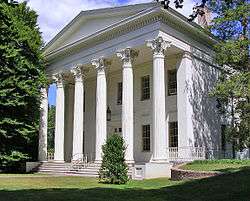
Three histories of Wesleyan have been published, Wesleyan's First Century by Carl F. Price in 1932, another in 1999, Wesleyan University, 1831–1910: Collegiate Enterprise in New England and Wesleyan University, 1910-1970, Academic Ambition and Middle-Class America, released in May 2015, both authored by David B. Potts. Wesleyan was founded as an all-male Methodist college in 1831.[9] The university, established as an independent institution under the auspices of the Methodist conference, was led by Willbur Fisk, its first president.[9] Despite its name, Wesleyan was never a denominational seminary.[10] It remained a leader in educational progress throughout its history[11][12][13] and erected one of the earliest comprehensive science buildings devoted exclusively to undergraduate science instruction on any American college or university campus, Judd Hall (named after alumnus Orange Judd).[14][15][16] It also has maintained a larger library collection than institutions comparable in size.[17][18] The Wesleyan student body numbered about 300 in 1910[19] and had grown to 800 in 1960, the latter being a figure that Time described as "small".[20] Although Wesleyan developed into a peer of Amherst and Williams, Wesleyan was always decidedly the smallest of the Little Three institutions until the 1970s, when it grew significantly to become larger than the other two.[21][22]
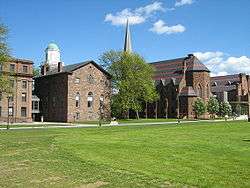
In 1872, the university became one of the first U.S. colleges to attempt coeducation by allowing a small number of female students to attend,[15] a venture then known as the "Wesleyan Experiment". "In 1909, the board of trustees voted to stop admitting women as undergraduates, fearing that the school was losing its masculine image and that women would not be able to contribute to the college financially after graduation the way men could."[23] Given that concern, Wesleyan ceased to admit women, and from 1912 to 1970, Wesleyan operated again as an all-male college.[13]
Wesleyan became independent of the Methodist church in 1937, although in 2000, the university was designated as a historic Methodist site.[24]
Beginning in the late 1950s, president Victor Lloyd Butterfield[25] began an ambitious program to reorganize the university according to Butterfield's "College Plan" somewhat similar to Harvard's House system or Yale's colleges, where undergraduate study would be divided into seven smaller residential colleges with their own faculty and centralized graduate studies, including doctoral programs and a Center for Advanced Studies (later renamed the Center for the Humanities).[26][27][28] The building program begun under this system created three residential colleges on Foss Hill (the Foss Hill dormitories) and then three more residential colleges (the Lawn Avenue dormitories, now called the Butterfield Colleges). Although the facilities were largely created, only four of the academic programs were begun, and only two of those continue today: the College of Letters and the College of Social Studies.[20][29] Fund raising proved highly effective and by 1960 Wesleyan had the largest endowment, per student, of any college or university in America, and a student-faculty ratio of 7:1.[30]
Butterfield's successors, Edwin Deacon Etherington (class of 1948)[31] and Colin Goetze Campbell,[32] completed many of the innovations begun during Butterfield's administration, including the return of women in numbers equal to men;[33] a quadrupling in the total area of building space devoted to laboratory, studio, and performing arts instruction; and a dramatic rise in the racial, ethnic, and religious diversity and size of the student body.[31][34][35][36][37]
The university and several of its admissions deans were featured in Jacques Steinberg's 2002 book The Gatekeepers: Inside The Admissions Process of a Premier College.[38][39] In the fall 2007 semester, Michael S. Roth, a 1978 graduate of Wesleyan and former president of the California College of the Arts, was inaugurated as the university's 16th president.[40]
Campus
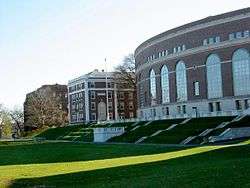
Wesleyan occupies a 360-acre (1.5 km2) campus, with over 340 buildings, including the five-building College Row; Olin Memorial Library (see below); Andrus Public Affairs Center; the Exley Science Center; Shanklin and Hall-Atwater Laboratories; the Van Vleck Observatory; Fayerweather with Beckham Hall; Russell House, a National Historic Landmark; the Allbritton Center; the Butterfield dormitories; the Fauver Field dormitories; and the 11-building Center for the Arts complex.[41][42]
When Wesleyan University was founded in 1831, it took over a campus on which two buildings, North College and South College, had already been built in 1825. They were originally constructed by the City of Middletown for use by Captain Partridge's American Literary, Scientific, and Military Academy. In 1829, after the Connecticut legislature declined it a charter to grant college degrees, Capt. Alden Partridge moved his academy to Northfield, Vermont. The academy later became Norwich University and the Middletown buildings were acquired by Wesleyan. The book, Norwich University, 1819-1911, Vol. I (1911), provides the following description of South College (originally called the Lyceum) and North College (called the Barracks).[43]
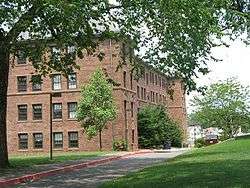
These buildings were constructed of brown sandstone from quarries in Portland, Connecticut. The "Barracks" was four stories high, 150 feet long and 52 feet wide, with a large attic and basement. Halls extended the full length of the building. The "Lyceum" was located 20 feet south of the Barracks, was three stories high, with a basement partly above the ground. At the front of the building was a tower 14×16 feet and 73 feet high. The basement floor was used for an arsenal and laboratory and the first and second floors for classrooms; the third floor called the "Hall of the Lyceum" was used as a chapel and drill room, and for public services.[44]
The original North College was destroyed in a fire in 1906, but South College survived, being converted into offices that same year. The cupola and the belfry, which contains the Wesleyan Carillon, was designed by Henry Bacon and was added in 1916.[45]
The original core buildings of the campus were North College and South College. North College, Nassau Hall-type building seen in most early American college campuses, was replaced after a fire in 1909 with the current North College. South College is the sole building from the beginning of the college. These two buildings were the first two in a line of six later called College Row. The other buildings of row include the recently renovated Memorial Chapel, the original college library (now a theater), and Judd Hall. Adjacent to College Row, Olin Library, Harriman Hall, Shanklin Hall, and the former Hall Chemistry Building were designed by the architectural firm of McKim, Mead, and White as a set (with Clark Hall and a never-built sixth building) to form a quadrangle.
The northern end of High Street contains several large buildings that were former private residences, a few of which were exceptional architectural examples. These include Russell House, a National Historic Landmark, two Alsop family houses, (one is currently the African-American Studies center with student housing; the other is the Davison Art Center), the Davison infirmary, a second Russell family house that contains the University Development Office, and Downey House. High Street, which is the old center of campus, was once described by Charles Dickens as "the most beautiful street in America".[46]
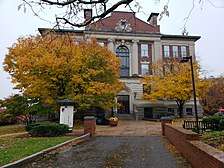
Recent building initiatives include the Freeman Athletic Center (which includes a 50-m swimming pool, the Spurrier-Snyder Rink for hockey, the 1,200-seat Silloway Gymnasium, the 7,500-square-foot (700 m2) Andersen Fitness Center, and the Rosenbaum Squash Center with eight courts); the Center for Film Studies; and a multibuilding renovation project creating a Humanities District on the east side of High Street between Fisk Hall and Russell House, which includes facilities for the departments of English, Romance Languages, the College of Letters, Classical Studies, Philosophy, and Art and Art History. The Allbritton Center (previously the Davenport Student Center, and before that Scott Lab) opened in the fall of 2009 and houses the Allbritton Center for the Study of Public Life, the Shapiro Creative Writing Center, the Quantitative Analysis Center, and the Feminist, Gender, and Sexuality Studies Program.[48][49]
The Usdan University Center, which opened in September 2007, has dining facilities for students and faculty. It also houses seminar and meeting spaces, the Wesleyan Student Assembly, Student Activities and Leadership Development Office, University Events and Scheduling Office, the post office, and the computer store. In 2012, 41 Wyllys Ave. opened in the former squash building as the new home for the College of Letters, Art History Program, and the Wesleyan Career Center.
Undergraduate academics
Wesleyan's 46 undergraduate academic departments offer over 900 courses each semester and more than 900 individual tutorials.[50][51] Wesleyan also offers 13 interdisciplinary programs and nine Academic Centers.[52][53][54][55] Undergraduates receive the Bachelor of Arts in one (or more) of 45 major concentrations.[56][57][58] As many as a third of these majors are interdisciplinary in structure.[59] Wesleyan began offering minors in February 2012 and at present offers eleven minors; more minors are under consideration.[60][61] Certificates are offered in eleven fields.[60] According to the university, "Certificate programs at Wesleyan supplement (but do not replace) a major. A certificate requires an interdisciplinary set of courses that prepares a student for postgraduate work in a specified interdisciplinary field."[62] In addition, double majors are popular and up to 40% of Wesleyan's graduates are double majors.[59] Students may triple major as well.[63] Undergraduates can also pursue a custom-designed major, known as a University Major.[64] According to the Columbia Encyclopedia, "Wesleyan is noted for its undergraduate programs of tutorial instruction and independent study."[65] Approximately 52% of students undertake independent study.[66]
Wesleyan offers 3–2 programs in engineering with the California Institute of Technology and Columbia University's School of Engineering. These programs allow undergraduates to receive degrees in five years from both Wesleyan (B.A.) and Caltech or Columbia (B.Sc., Engineering).[65][67][68] Additionally, Wesleyan offers a BA/MA Program in the sciences leading to a bachelor's degree in the fourth year and a master's degree in the fifth year. Tuition for the fifth year of the master's degree is waived.[69] Undergraduates can pursue studies in pre-medicine, pre-law, and pre-business through any major.[70] Most classes at Wesleyan are small; the predominant class size for undergraduates is 10–19 students, and the student to faculty ratio is 8 to 1.[71][72]
The university has described a set of general principles that define its approach to undergraduate education summed up in ten essential capabilities that the faculty believe every undergraduate should possess when he or she graduates from Wesleyan.[63][73][74] Students may acquire these capabilities through numerous courses throughout the curriculum designated by the faculty as satisfying specific capabilities and through extra- or co-curricular activities.[73][75][76][77][78] Writing is emphasized across the disciplines and 99% of undergraduates participate in Wesleyan's Writing Across the Curriculum program.[79]
Wesleyan does not require undergraduates to take prescribed courses.[80][81] Freshmen are offered First Year Initiative seminars, which are designed to prepare them for upper-level courses by emphasizing writing, analysis, discussion, and critical thinking.[82] Undergraduates are encouraged in the first two years of study to take a minimum of two courses from two different departments in each of three areas: natural sciences and mathematics, humanities and the arts, and social and behavioral sciences.[83] In the second two years, undergraduates are expected to take one course in each of these three areas. Fulfillment of the General Education Expectations in conjunction with co-curricular activities provides simultaneous acquisition of the ten essential capabilities. "A student who does not meet these [general education] expectations by the time of graduation will not be eligible for University honors, Phi Beta Kappa, honors in general scholarship [honors or high honors], and for honors in certain departments."[59][84]

College of East Asian Studies
The College of East Asian Studies (CEAS) is the home of East Asian studies at Wesleyan University. The College was established in July 2014 through the merger of three academic units: the Asian Languages and Literatures Department, the East Asian Studies Program, and the Mansfield Freeman Center for East Asian Studies.
The CEAS Major is a three-year long major that is designed to give students deep knowledge about a particular East Asian culture (China, Japan, Korea) that are grounded in a particular discipline. Majors are also required to gain some knowledge of the other East Asian countries that might not be the focus of their study.
College of the Environment
The College of the Environment (COE), created in 2009, integrates the following components: 1) a curricular component, including the newly established environmental studies major, the environmental studies certificate, and a senior capstone project; 2) a Think Tank of Wesleyan faculty, scholars of prominence, and undergraduates whose aim is to produce scholarly work that will influence national and international thinking and action on critical environmental issues; and 3) the Collaborative Research Initiative (CRI), which is designed to encourage COE majors with the most potential to undertake environmental research. The threefold goal of the CRI combines: a) preparing students for senior research work; b) recruiting students of exceptional skill for participation in the COE Think Tank; and c) preparing students for research careers in environmental studies, as well as facilitating internships (non-credit) to provide students with research opportunities and "real world" experience (e.g., internships with governmental organizations, NGO's, and businesses, etc.).[85][86][87]
College of Film and the Moving Image
The university's Film Studies program, consistently ranked in the top ten among the best programs in the world,[88][89][90][91][92] is led by film historian Jeanine Basinger.[93] In 2008, Vanity Fair said: "This tiny Connecticut University, with a total enrollment of 2,700, has turned out a shockingly disproportionate number of Hollywood movers and shakers."[94][95] Similarly, in 2008, Variety magazine noted Basinger's contribution to the film industry through her work in the Wesleyan Film Studies program, and the large number of alumni of the program now working in Hollywood.[96] University students, biographers, media experts, and scholars from around the world may have full access to The Wesleyan Cinema Archives, which document the film industry during the 20th century and contain the personal papers and film related materials of Ingrid Bergman, Frank Capra, Clint Eastwood, Federico Fellini, Elia Kazan, Frank Perry, Roberto Rossellini, Robert Saudek, Martin Scorsese, Gene Tierney, Raoul Walsh, and John Waters, amongst others.[97][98]
In February 2013, Wesleyan announced the creation of a new College of Film and the Moving Image, incorporating the Film Studies Department, the Center for Film Studies, the Cinema Archives and the Wesleyan Film Series.[99]
College of Integrative Sciences
The College of Integrative Sciences (CIS) is the most recent interdisciplinary college at Wesleyan, founded in 2014. The College was motivated by the recognition that the most significant innovations in science and technology today come by combining the expertise of multiple disciplines. Accordingly, the CIS provides students with an interdisciplinary education in the sciences, and combines it with hands-on problem solving skills in research. Through research, students are transformed from consumers into creators of knowledge. CIS students gain both the formal background and the practical training needed to be successful in the competitive arena of technology development. To build interdisciplinary expertise, students must complete both a traditional major in science or mathematics, as well as a "linked" major that combines components from other disciplines to form a coherent plan of study.[100]
College of Letters
The College of Letters (COL) combines the study of history, literature, philosophy, and a foreign language of the student's choice. The program has a primary focus on the Western canon.[101] Undertaking a chronological study that progresses from antiquities to modernity, COL students take one colloquium together each semester and study abroad for the second semester of their sophomore year; they are expected to be at an intermediate level of study in their language of choice at the time they enter the program as sophomores. During their junior year students prepare for intensive comprehensive examinations on the three colloquia taken up to this point. During their senior year students must write a thesis (full year paper) or an essay (half year paper).[102]
College of Social Studies
The College of Social Studies (CSS) was founded in 1959, combining the fields of history, economics, government, and philosophy. It emphasizes intellectual independence and collaborative and social ties between faculty and students. Students take 5.5 of the program's 10.5 (thesis-writing students take 11.5) required credits during their sophomore year. Sophomore year focuses on the development of modern Western society from historical, economic, social and political perspectives, and culminates with comprehensive final exams. Junior year has a more global focus, while Seniors are required to write an Honors thesis (full year) or a Senior Essay.[103][104][105]
Science and mathematics
According to National Science Foundation (NSF) research and data, the university ranks first nationally among liberal arts colleges in federal funding for research in the sciences and mathematics. Wesleyan is the sole undergraduate liberal arts college to be designated a Molecular Biophysics Predoctoral Research Training Center by the National Institutes of Health (NIH) among research universities such as Stanford, University of California at Berkeley, Johns Hopkins, Harvard University Medical School, Duke, Cornell, and the University of Pennsylvania.[106] Medical school acceptances historically have averaged above 90% and in some years Wesleyan has recorded an acceptance rate of 100%. Many pre-med graduates are admitted to the most prestigious programs in the country.[107][108]
Wesleyan was one of the first colleges to establish a separate Molecular Biology & Biochemistry department, and has extensive laboratory facilities.[107] The university is reputed to have the most square footage of lab space per student of any college in the country. All of the science departments, mathematics & computer science and psychology support original post-graduate research programs. An additional laboratory building is in the planning stages.
- Astronomy program
The Astronomy department graduates more astronomy and astrophysics majors than any other liberal arts college in the country.[109] The program is based at Van Vleck Observatory, built in 1914, which is on Foss Hill near the center of the Wesleyan campus.
- Science in Society
Wesleyan's Science in Society Program (SISP) is an interdisciplinary major that encourages integrated study of the sciences and medicine as practices, institutions, and intellectual achievements, among other areas of study. The program has three components: science courses, SISP courses, and an area of concentration (which may include a major in one of the sciences). The program is well suited for students interested in a variety of professional and academic pursuits, since it encourages students to integrate technical scientific understanding with a grasp of the multiple contexts in which scientific knowledge is applied, and the issues at stake in its application.[110]
Music
Wesleyan's program in World Music, described as "one of the top schools in the country for the study of ethnomusicology"[111][112] and music, employs leading teaching musicians and ethnomusicologists, representing a variety of musical traditions. European (including Medieval, Renaissance, Baroque, Classical, Romantic, Impressionistic, Expressionistic, Neoclassical, Neoromantic, Gebrauchsmusik, 20th century, Contemporary, and Opera), South Indian Classical, Indonesian (including Javanese Gamelan), East Asian, classical Chinese music, Korean music, Japanese music including Taiko drums, West African, Caribbean, African-American, as well as Experimental music have been permanent components of the Music Department since the 1960s.[113] The Experimental music work at Wesleyan dates to the residency of John Cage at the university, and subsequently to Alvin Lucier, Ron Kuivila, and Jon Barlow. Among universities, Wesleyan "has one of the largest and most diverse collections of world musical instruments,"[114] many of which are depicted in the university's "Virtual Instrument Museum."[115]
Theater
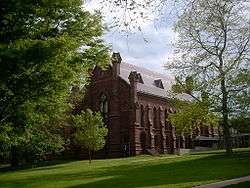
Wesleyan's highly regarded theater program makes use of two theater facilities: the Theater in the Center for the Arts, a 400-seat space, and the '92 Theater, home to Second Stage, which may be the country's first solely student-run volunteer theater organization. Second Stage produces at least one performance per weekend during the school year, either in the fully equipped black-box Patricelli '92 Theater or alternative spaces around campus. Second Stage produces dance as well as theater performances. The Patricelli '92 Theater (then simply '92 Theater) became available for student-run productions when the Center for the Arts opened in 1974, providing the Theater Department with a state-of-the-art facility.[116][117][118]
International study
Wesleyan sponsors, among others, international programs in France, Italy, and Spain, and has special relationships with programs in Japan. Nearly 45 percent of [Wesleyan] students study abroad through 150 programs located in 50 countries worldwide."[119]
Twelve College Exchange
Many students participate in the Twelve College Exchange program, which allows for study for a semester or a year at another of the twelve college campuses: Amherst, Bowdoin, Connecticut College, Dartmouth, Mount Holyoke, Smith, Trinity, Vassar, Wellesley, Wheaton, and the Williams/Mystic Seaport Program in Maritime Studies.[120][121]
Post-graduate academics
- Departmental programs
Wesleyan has 11 graduate departmental programs in the sciences, mathematics, computer science, psychology, and music.[122] Graduates receive the Master of Arts or Doctor of Philosophy degrees.[119] Like in many traditional liberal arts colleges in the United States, all of Wesleyan's master's and bachelor's degrees are designated "of Arts" by historical precedent, regardless of the field of study.[123][124]
- Graduate Liberal Studies Program
In 1953, Wesleyan was the first university to begin a program leading to a Master of Arts in Liberal Studies degree, called the Graduate Liberal Studies Program.[125] To date, hundreds of educational institutions have followed suit with similar programs.[126] The program provides for interdisciplinary graduate study independent of the undergraduate academic departments.[127]
A large proportion of G.L.S.P. students are public and private school teachers from the region, and the others are in different professions or are otherwise augmenting their graduate studies.[128] The Graduate Liberal Studies Program offers both the Master of Arts in Liberal Studies (MALS) and the Master of Philosophy (M.Phil.) degree. The former requires 36 credit hours of study and may culminate in a capstone project or thesis. The latter requires 30 credit hours of academic study and a thesis.
- Massive Open Online Courses (MOOCs)
Beginning in 2012, Wesleyan became the first small liberal arts college to partner with a private consortium to design and offer free public access online courses.[129] Wesleyan teaches online courses in Math, Computer Science, Law, Psychology, and Literature, as well as other subjects. In January 2015, total worldwide student enrollment in online courses taught by Wesleyan faculty exceeded 1,000,000.[130]
Academic profile
Admissions
For the Class of 2023 (enrolling Fall 2019), Wesleyan received 13,264 applications and accepted 2,186 (16.5%), with 771 enrolling.[131] The middle 50% range of SAT scores for enrolling freshmen was 670-770 for math, and 650-740 for evidence-based reading and writing.[131] The middle 50% ACT score range was 28-33 for math, 32-35 for English, and 31-34 for the composite.[131]
Admission standards at Wesleyan are considered "most selective" by U.S. News & World Report.[132] The Princeton Review gives the university an admissions selectivity rating of 97 out of 99.
Beginning with the 2014–2015 admissions cycle, Wesleyan no longer requires students from the United States or Canada to submit SAT or ACT scores as part of their applications.[133]
Rankings
| University rankings | |
|---|---|
| National | |
| Forbes[134] | 40 |
| THE/WSJ[135] | 43 |
| Liberal arts colleges | |
| U.S. News & World Report[136] | 17 |
| Washington Monthly[137] | 9 |
In the 2020 U.S. News & World Report rankings, Wesleyan University is tied for 17th in National Liberal Arts Colleges.[138] In previous years, Wesleyan has been ranked as high as 6th. Wesleyan was also ranked 2nd in Best Colleges for Veterans.[138]
In 2019 Kiplinger ranked Wesleyan 16th of the 149 best value liberal arts colleges in the United States.[139]
In the 2019 Forbes ranking of 650 American colleges, which combines national research universities, liberal arts colleges and military academies in a single survey, Wesleyan University is ranked 40th overall and 12th among liberal arts colleges alone.[140] According to a study entitled "Revealed Preference Ranking" published by the National Bureau of Economic Research, Wesleyan ranks No. 22 among all colleges and universities, and No. 5 among liberal arts colleges only.[141] The stated purpose of the NBER study was to produce a ranking system that "would be difficult for a college to manipulate" by basing it on the actual demonstrated preferences of highly meritorious students.[141] Wesleyan was listed on the Foundation for Individual Rights in Education's 2016 "10 Worst Colleges for Free Speech".[142]
Washington Monthly ranked Wesleyan 9th in 2019 of 214 liberal arts colleges in the U.S. based on its contribution to the public good, as measured by social mobility, research, and promoting public service.[143]
The university is notable for the success with African American students, in which Wesleyan is one of nine universities with a black graduation rate above 90 percent.[144]
After graduation
Wesleyan has been noted as one of the most productive baccalaureate colleges in the United States in the undergraduate origins of PhDs in all fields of study, with exceptional productivity in undergraduates pursuing doctorates in the physical sciences, geosciences, life sciences, psychology, social sciences, and humanities.[107][145][146][147] According to studies undertaken by the National Science Foundation, the National Institutes of Health and other federal agencies, for the years 1999–2008, 1999–2003, and 1994–2003, Wesleyan undergraduates were second in receiving PhDs among all liberal arts colleges in the nation.[145][148][149] For example, the university produces more history doctorates per undergraduate history major than any other liberal arts college or national research university in the United States (with the exception of the University of Chicago which tied for first place with Wesleyan in a study (by the American Historical Association) of history PhDs earned between 1989 and 2002).[150]
According to a 2003 summary, women constituted 55.3% of Wesleyan's undergraduates who received doctorates.[148] Similarly, "[a]ccording to the 2000 to 2004 Survey of Earned Doctorates, women accounted for nearly 63% of the doctorates received by Wesleyan alumni/ae in the sciences (calculated either including psychology or including both psychology and the social sciences) and earned 53% of the doctorates in the sciences when psychology and the social sciences were excluded."
Eighty percent of Wesleyan alumni attend graduate or professional school within five years of graduation.[151][152] In 2011, Newsweek ranked Wesleyan eighteenth in their list of the nation's best colleges and universities for paying back graduates in future earnings and quality experience.[153][154]
Wesleyan graduates are awarded external fellowships, including Fulbright, Goldwater, Marshall, Rhodes, Truman, and Watson.[155][156] For the years 2004 through 2012, for example, Wesleyan was named a "Top Producer of Fulbright Awards for American Students" by the Institute for International Education.[157][158][159][160][161][162][163] For the years 2007 through 2011, a total of 42 Wesleyan students and alumni received scholarships under the Fulbright program.[164][165][166][167][168] The university has had at least 87 Watson Fellows since the inception of the program in 1968.[169]
Libraries

Wesleyan University has an extensive library collection, most of which is housed in Olin Memorial Library, which has more than 1.8 million volumes and approximately 10,000 serial subscriptions.[18][170][171] Wesleyan's first library was Rich Hall (now '92 Theater), which was built just after the Civil War.[116][172] Olin Library was designed by the firm of McKim, Mead, and White, built in 1925–27 and dedicated in 1928.[170] Olin originally was much smaller and also contained classroom space. It has since been enlarged twice, the last time in 1992.
The second largest library on campus is the Science Library, which houses over two hundred fifty thousand volumes of science abstracts, books, journals, monographs, papers, periodicals, and surveys.[173] The Science Library also has a large collection called the Cutter Collection, which is an older private collection of mostly 19th century English language books of European literature, art, and culture.
The Art Library is housed on the second floor of Olin Library. Davison Art Center holds the Print Reference Library. There is also a Music Library (which includes scores and recordings and the World Music Archives) and several department libraries.[174]
Davison Art Center
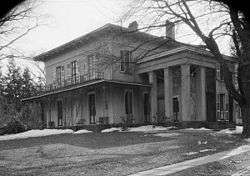
Wesleyan University's Davison Art Center is in Alsop House, which is designated a U.S. National Historic Landmark.[175][176] The Art Center has a large collection consisting primarily of works on paper, including 18,000 prints, 6,000 photographs, several hundred drawings, a small number of paintings, and three-dimensional objects (including artists' books, sculptures, and other objects).[177][178][179] The print collection is considered to be one of the most important at an American university, with works by Dürer, Goya, Rembrandt, Manet, and others.[180][181][182] Parts of the collection are regularly exhibited to the public. Some objects have been made available for loan to selected museums in the United States and abroad.[183] Students at Wesleyan in many departments make use of the DAC collection for class assignments, viewings, and individual research projects under the guidance of faculty.[184][185][186]
The Art Center's publications program produces catalogs concerning DAC collections and gallery exhibitions. In general, one catalog is published annually. This program affords students the opportunity to take part in carefully mentored student authorship. Additionally, it is a critical component of the museum's educational program, which also includes student museum internships and solely student-curated exhibitions.[180][187][188]
Wesleyan University Press
The Wesleyan University Press is well regarded for its books of poetry[189] and books on music, dance and performance, American studies, and film. The press also connects the campus to the larger intellectual and cultural world through the presence of its authors on campus, whether they are faculty, visiting scholars, guest lecturers, or participants in Wesleyan's Distinguished Writers Series or Writers Conference.[190]
Student life
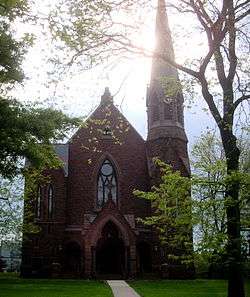
Campus safety
In 2014, Wesleyan had 11.5 total reported rapes per one thousand students, the second-highest number of reports per thousand in the nation. Nationwide victims' advocates have called the increased number of reports throughout the country a positive trend, with a growing number of students voluntarily telling authorities about incidents that, in the past, may instead have gone unreported.[191]
Cannon Scrap
In the late 1860s, a yearly contest, the "Cannon Scrap," began between the freshmen, whose mission it was to fire the Douglas Cannon on February 22, and the sophomores, who were charged with foiling the effort. In 1957, the tradition of stealing the cannon began in earnest.[192][193]
Religious life
Wesleyan's Memorial Chapel is the heart of religious life on campus. The university employs a Jewish rabbi, a Catholic priest, a Protestant chaplain, and a Muslim chaplain.[194] There is also program housing for Buddhists, Muslims, Christians, and Jews.[195] Within the Memorial Chapel there are meditation rooms.[196] There is a Wesleyan program in Israel.[197]
Athletics
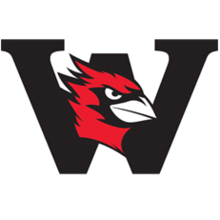

Wesleyan is a member of the Division III New England Small College Athletic Conference (NESCAC), fields intercollegiate varsity teams in 29 sports, and competes against traditional Little Three rivals Amherst and Williams. Approximately 600 students participate in intercollegiate varsity sports each year.[198] Wesleyan is one of the 39 founding members of the NCAA.[199] Wesleyan's football and baseball field, Andrus Field, is the oldest continuously used American football field in the world[200][201] and the oldest continuously used baseball field in the world.[202] In 2018, Wesleyan's Men's Lacrosse team won the Division III NCAA championship title.
| Men's Teams (Head Coach) | Women's Teams (Head Coach) | ||
|---|---|---|---|
| Baseball | Mark Woodworth | Basketball | Kate Mullen |
| Basketball | Joe Reilly | Crew | Pat Tynan |
| Crew | Phil Carney | Cross country | John Crooke |
| Cross country | John Crooke | Field hockey | Christine Kemp |
| Football | Dan DiCenzo | Golf | Jon Wilson |
| Golf | Jeff Gilarde | Ice hockey | Jodi McKenna |
| Ice hockey | Chris Potter | Lacrosse | Kim Williams |
| Lacrosse | John Raba | Soccer | Eva Meredith |
| Soccer | Geoff Wheeler | Softball | Jen Lane |
| Squash | Shona Kerr | Squash | Shona Kerr |
| Swimming & Diving | Peter Solomon | Swimming & Diving | Peter Solomon |
| Tennis | Mike Fried | Tennis | Mike Fried |
| Track & Field | Walter Curry | Track & Field | Walter Curry |
| Wrestling | Drew Black | Volleyball | Ben Somera |
Student groups and organizations
In February 2011, U.S. News & World Report described the university as one of "20 Colleges Where It's Easiest to Get Involved" with a "Students per Club" ratio of "11.66". At that time there were around 270 student groups available to the 3148 enrolled students.[203]
Wesleyan Student Assembly
The Wesleyan Student Assembly (WSA) is a body of 38 students elected annually to represent Wesleyan University's undergraduate student body. The members of the assembly serve as student advocates in all areas of the university, including matters related to student life, academics, university finances, and campus facilities.[204][205][206][207]
Debate
The Debate Society was founded in 1903 and later named in honor of Woodrow Wilson, who had been a professor at Wesleyan between 1888–1890 and who "became deeply involved in extracurricular student activities such as the [Wesleyan] debate society."[208] He "stimulated students to organize opportunity for debate through a House of Commons similar to the one he had started at Johns Hopkins in 1884."[209][210] It captured first place in past years at the annual Brown, Columbia, Georgetown, Harvard,[211] Princeton, Tufts and Williams tournaments, among others, and has reached the semi-finals of all other major tournaments. The Debate Society also has competed internationally, and in 1990 the Society won a national championship[212] and ninth place in the World Student Debating Championships.
Environmental
Another student group is the Environmental Organizers' Network (EON), which campaigns on environmental issues.[213][214] Wesleyan also owns a tract of land that is used as Long Lane Farm, a 2-acre (8,100 m2) organic vegetable farm run by students.[215]
Publications
Some of the oldest and most visible student groups are campus publications, including a bi-weekly newspaper, The Wesleyan Argus and a periodical, Hermes, the university's oldest student-run progressive publication.[216] Until 2008, the student body published the Olla Podrida which was originally a quarterly newspaper in the late 1850s, but became the college yearbook since the Civil War and the permanent establishment of the Argus as the campus newspaper.[217] Wesleying is a student-run weblog that documents undergraduate life at Wesleyan, often receiving up to 10,000 page views a day.[218] The Ankh, founded in 1985, is a twice-yearly publication composed entirely by Wesleyan students of color. Overall, at least "fifteen student publications are sent to press ... once a semester, ranging from the school newspaper, The Argus, to magazines of fiction, humor, women’s issues, activism, and poetry."
Singing groups
Wesleyan was long known as the "Singing College of New England."[219] The university's "tradition as a 'singing college' had its roots in the vitality of Methodist hymnody."[220] Glee clubs were formed "for special occasions from the mid-1840s through the 1860s".[220] In 1862, however, a University glee club made the first tour of Wesleyan singers. The Wesleyan glee club organized by students frequently traveled and performed from the mid-19th century through the mid-20th century[221][222] and was considered among the best collegiate glee clubs in the late 19th century.[223] It traveled widely giving concerts, including being received twice at the White House (in 1901 by President McKinley and again in 1928 by President Coolidge) and being recorded onto a phonograph record by Thomas Edison.[223] University alumni published the first edition of The Wesleyan Song Book in 1901.[221] Subsequently, the Glee Club twice won the National Intercollegiate Glee Club Competition at Carnegie Hall.[224] Since the Glee Club's disbanding, the tradition of choral singing has been carried on by the Wesleyan Singers, later renamed the Wesleyan Concert Choir, and then renamed again The Wesleyan Ensemble Singers (2010). This tradition also continues today in several student-run a cappella groups on campus, including the Wesleyan Spirits, the university's oldest group. There are at least 7 groups that perform on campus regularly,[225] with others occasionally created and disbanded.
The multi-award-winning musical In the Heights, was written by Lin-Manuel Miranda (class of 2002) during his Sophomore year and was first produced at Wesleyan.[226]
Greek organizations and secretive societies

Wesleyan has chapters of Alpha Delta Phi, Alpha Psi Alpha, Chi Psi, Psi Upsilon, and Delta Kappa Epsilon.[227]
In 2011, Rho Epsilon Pi sorority was founded at Wesleyan University in order to provide a social space for women on campus.
In September 2014, Wesleyan ordered all fraternities with on-campus housing to become co-educational within the next three years.[228] In 2015, Wesleyan University ordered the closure of the DKE fraternity house on High Street. In 2017, DKE won the claim against Wesleyan University in a court trial. The jury awarded damages of $386,000 to the Kent Literary Club, DKE's Wesleyan alumni chapter. [229]
Secretive societies on campus include the Skull & Serpent,[230] Theta Nu Epsilon,[231] Cloak, The Cannon Society, Pigs of Patio, and two Mystical Sevens.
Student activism
- Need-blind admissions
Until 2012, Wesleyan adhered to a need-blind admission policy.[232] Financial circumstances were not considered when deciding whether to admit, wait list, or turn down an applicant. In 1982, trustees announced that, following federal cuts to student aid, Wesleyan would begin to consider financial circumstances when admitting wait-listed students. Students protested the decision,[233] and though trustees did not back down from their recommendations, Wesleyan raised enough money for financial aid to avoid putting the new policy into effect.[234] In 1992, the administration again considered a moratorium on need-blind admissions. A student group, Students for Financially Accessible Education (SFAE), organized a series of actions including rallies, a silent vigil encircling a trustee meeting, a sit-in in an administration building, and a camp-out on its lawn. Wesleyan's need-blind admissions policy was preserved. SFAE continued to raise awareness about financial accessibility, offering interest-free loans to students with financial emergencies, and raising money for financial aid through energy conservation campaigns. Again in 2012, the Wesleyan administration proposed shifting away from its need-blind policy beginning with the class of 2017. As with the previous instances, this proposal was met with protest from the student body.[235]
- WESU and National Public Radio
Another controversy in the early 2000s was the status of the campus radio station, WESU,[236] founded in 1939.[237] Until 2004, WESU's format had been entirely free-form, with DJs and student staff having complete freedom to program what they will. The station now broadcasts an NPR feed from WSHU, the college station of Sacred Heart University, for several hours a day.[238] For the remainder of the broadcast day, WESU continues to operate as a free-form station.[239]
Literary, media, and cultural references
More than 30 books have been published concerning the university, including: The Wesleyan Song Book, by Karl P. Harrington and Carl F. Price (1901); [240] The Goose-Step: A Study of American Education, by Upton Sinclair (1923); Wesleyan's First Century With an Account of the Centennial Celebration, by Carl F. Price (1932);[241] Wesleyan University, 1831–1910: Collegiate Enterprise in New England, by David B. Potts (1999);[242] The Gatekeepers: Inside The Admissions Process of a Premier College, by Jacques Steinberg (2002); One Hundred Semesters: My Adventures as Student, Professor, and University President, and What I Learned along the Way, by William M. Chace (14th President of Wesleyan) (2006);[243] A History of the Eclectic Society of Phi Nu Theta, 1837–1970, by William B.B. Moody (2007);[244] Hidden Ivies: Thirty Colleges of Excellence, by Howard Greene and Matthew Greene (2000); Hidden Ivies: 50 Top Colleges that Rival the Ivy League, by Howard Greene and Matthew Greene (2009); Music at Wesleyan: From Glee Club to Gamelan by Mark Slobin (2010).[245]
The main character, Girl, in the 2004 novel Citizen Girl (ISBN 0743266854), by the authors of The Nanny Diaries, is a graduate of Wesleyan.[246] John Maher's 1995 work Thinker, Sailer, Brother, Spy: A Novel (ISBN 0964312107) features a fictional look at the life of a professor (a principal character) in the "hothouse atmosphere of Wesleyan University...."[247] Two of Robert Ludlum's novels are set partially at Wesleyan, The Matlock Paper much of the action takes place in and around the campus of a thinly disguised Wesleyan,[248] and also The Chancellor Manuscript where Ludlum refers to Wesleyan as 'a wealthy but minor university'.
The 1963 comedic novel, Night and Silence Who is Here?, by novelist Pamela Hansford Johnson, is thought by many literary critics to be patterned humorously after Wesleyan's Institute for Advanced Studies (now the Center for the Humanities); the main characters comprise and parallel the cast of Shakespeare's Midsummer Night's Dream.[249] The Eclectic Society, a play that premiered on 27 January 2010 at the Walnut Street Theatre is based upon the Eclectic Society at the university during the early 1960s.[250][251] In the 2012 novel Dream School, by novelist Blake Nelson, the protagonist attends an eastern liberal arts college, Wellington College, modeled on Wesleyan.[252]
Characters in several television series have been portrayed as Wesleyan students or graduates. They include 30 Rock,[253][254] As the World Turns,[255][256] How I Met Your Mother (characters Ted Mosby, Marshall Eriksen, Lily Aldrin),[257][258] Buffy the Vampire Slayer,[259] The West Wing,[260] BoJack Horseman,[261][262] and M*A*S*H.
The 1994 cult comedy film PCU was based on (and filmed in part at) Wesleyan, the alma mater of the screenplay's two writers, Adam Leff and Zak Penn, and represents "an exaggerated view of contemporary college life...."[263] centering on a fictionalized version of the Eclectic Society, known in the film as "The Pit."[264][265][266]
In the autumn of 2010, the Pulitzer prize-winning comic strip Doonesbury by Garry Trudeau featured the university in a series of daily strips.[267]
In 2015, Rolling Stone published a long form feature on Wesleyan's drug culture titled "Inside the Wesleyan Molly Bust",[268] where dozens of students overdosed on tainted ecstasy, leading to the expulsion of five students.
Notable alumni and faculty
Former Wesleyan faculty and affiliates V. S. Naipaul, Woodrow Wilson, and T. S. Eliot have been awarded Nobel Prizes. Gary Yohe, current Professor of Economics, won a 2007 Nobel Peace Prize. Satoshi Omura, Max Tishler Professor of Chemistry, was awarded the 2015 Nobel Prize for Medicine. Former faculty and affiliates Richard Wilbur, Mark Strand, and Donald Hall were United States Poets Laureate. Composers John Cage and Steve Lehman were both affiliated with the university. Film notables include Joss Whedon, a producer, director, screenwriter, comic book writer, and composer; Lin-Manuel Miranda, creator of Hamilton, won a Pulitzer Prize, three Grammy Awards, an Emmy Award, a MacArthur Fellowship, and three Tony Awards; and Michael Bay, film producer and director.[269]
_(cropped).jpg)
.jpg)
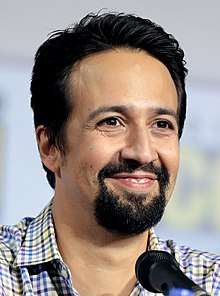

.jpg)

.jpg)
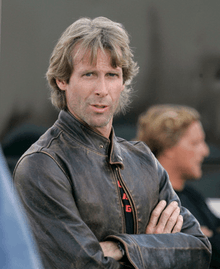
_(cropped).jpg)
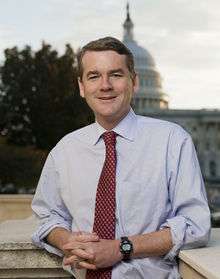
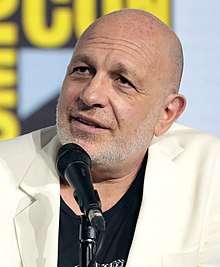
 D.B. Weiss
D.B. Weiss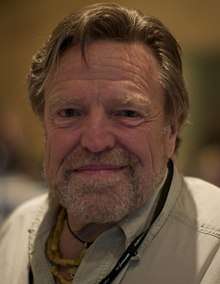
References
- As of June 30, 2019. "FY 2019 YEAR END LETTER" (PDF). Wesleyan University. Retrieved May 5, 2020.
- "Common Data Set 2019-2020, Part I" (PDF). Wesleyan University. Retrieved May 5, 2020.
- "Common Data Set 2019-2020, Part B" (PDF). Wesleyan University. Retrieved May 5, 2020.
- "NAICU - Membership". Archived from the original on November 9, 2015.
- "New England Small College Athletic Conference". Nescac.com. Archived from the original on 14 May 2008. Retrieved 25 August 2012.
- "About Wesleyan: University History [Wesleyan University]". 2009-03-30. Archived from the original on 2009-03-30. Retrieved 2019-05-05.
- "Connecticut College : News : Centennial video generates excitement". 2012-03-05. Archived from the original on 2012-03-05. Retrieved 2019-05-05.
- "National Historic Landmarks Program (NHL)". 2011-06-06. Archived from the original on 2011-06-06. Retrieved 2020-02-13.
- Page 22-23 Archived 2015-09-06 at the Wayback Machine. Books.google.com (12 November 1909). Retrieved on 17 October 2011.
- Page 23 Archived 2015-09-06 at the Wayback Machine. Books.google.com (12 November 1909). Retrieved on 17 October 2011.
- Pages 118, 126–130, 135–138, 139, 143, 145 Archived 2015-09-06 at the Wayback Machine. Books.google.com (12 November 1909). Retrieved on 17 October 2011. Pages 118, 126–130, 135–138, 139, 143, 145. Books.google.com (12 November 1909). Retrieved on 17 October 2011.
- Second paragraph Archived 2011-10-18 at the Wayback Machine. Chestofbooks.com. Retrieved on 17 October 2011.
- Page vii Archived 2015-09-06 at the Wayback Machine. Books.google.com (12 November 1909). Retrieved on 17 October 2011.
- Pages 129–130 Archived 2015-09-06 at the Wayback Machine. Books.google.com (12 November 1909). Retrieved on 17 October 2011.
- WESLEYAN UNIVERSITY. – Dedication of Judd Hall of National Science Presentation Address by Orange Judd-Dedicatory Address by Prof. Winchelle-Memorial Chapel The Woman Question. JUDD HALL OF NATURAL SCIENCE. DEDICATORY ORATION. DEDICATION OF THE MEMORIAL CHAPEL. THE ADMISSION OF WOMEN. – Article – NYTimes.com Archived 2013-11-04 at the Wayback Machine. New York Times (9 October 2011). Retrieved on 17 October 2011.
- Page 267 Archived 2015-09-06 at the Wayback Machine. Books.google.com (19 November 2008). Retrieved on 17 October 2011.
- pp. 130–132 Archived 2015-09-06 at the Wayback Machine. Books.google.com (12 November 1909). Retrieved on 17 October 2011.
- Library & Museum Information, Wesleyan University Archived 2011-05-08 at the Wayback Machine. Colleges.usnews.rankingsandreviews.com (31 January 2011). Retrieved on 17 October 2011.
- "Chapter 17, "The Wesleyan Story: The Importance of Moral Capitol", Burton R. Clark, pp. 369" (PDF). Archived (PDF) from the original on 17 October 2015. Retrieved 25 August 2012.
- "Education: New Look at Wesleyan". Time. 18 April 1960. Archived from the original on 20 February 2011. Retrieved 22 May 2011.
- "Chapter 17, "The Wesleyan Story: The Importance of Moral Capitol", Burton R. Clark, pp. 375, 378" (PDF). Archived (PDF) from the original on 17 October 2015. Retrieved 25 August 2012.
- Appendix Three: Enrollments at Wesleyan, Amherst, and Williams, 1831–1990, Page 238 Archived 2012-04-01 at the Wayback Machine. Lib.muohio.edu (1 October 2011). Retrieved on 17 October 2011.
- Connecticut Closeup: Wesleyan University – Hartford Courant. Courant.com (5 July 2011). Retrieved on 17 October 2011.
- "Wesleyan History 101: 1831-2009". The Wesleyan Argus. Archived from the original on 23 March 2010. Retrieved 30 June 2007.
- DR. BUTTERFIELD HEADS WESLEYAN – Named President to Succeed McConaughy, Who Resigned for China Relief Post – Article – NYTimes.com Archived 2018-07-23 at the Wayback Machine. Select.nytimes.com (9 October 2011). Retrieved on 17 October 2011.
- "Chapter 17, "The Wesleyan Story: The Importance of Moral Capitol", Burton R. Clark, p. 372, pp.369-378" (PDF). Archived (PDF) from the original on 17 October 2015. Retrieved 25 August 2012.
- Paragraphs 5 & 7 and 1st Reference Archived 2011-09-28 at the Wayback Machine. Aacu.org. Retrieved on 17 October 2011.
- Connecticut Archives Online Archived 2012-01-13 at the Wayback Machine. Library.wcsu.edu. Retrieved on 17 October 2011.
- "Chapter 17, "The Wesleyan Story: The Importance of Moral Capitol", Burton R. Clark, p. 372" (PDF). Archived (PDF) from the original on 17 October 2015. Retrieved 25 August 2012.
- Albert E. Van Dusen, Connecticut (1961) p 365
- Edwin Etherington, 76, Ex-Amex President – New York Times Archived 2016-05-08 at the Wayback Machine. Nytimes.com (15 January 2001). Retrieved on 17 October 2011.
- "Chapter 17, "The Wesleyan Story: The Importance of Moral Capitol", Burton R. Clark, p. 379-381" (PDF). Archived (PDF) from the original on 17 October 2015. Retrieved 25 August 2012.
- Education: Boy Hopes to Meet Girl Archived 2011-12-20 at the Wayback Machine. TIME (22 December 1961). Retrieved on 17 October 2011.
- Education: New Look at Wesleyan Archived 2011-02-20 at the Wayback Machine. TIME (18 April 1960). Retrieved on 17 October 2011.
- LIFE – Google Books Archived 2015-09-06 at the Wayback Machine. Books.google.com (14 February 1969). Retrieved on 17 October 2011.
- "Chapter 17, "The Wesleyan Story: The Importance of Moral Capitol", Burton R. Clark, pp. 375-376, 378-381" (PDF). Archived (PDF) from the original on 17 October 2015. Retrieved 25 August 2012.
- Tensions on Campus: Hope Amid the Rage – New York Times Archived 2018-02-03 at the Wayback Machine. Nytimes.com (27 May 1990). Retrieved on 17 October 2011.
- Gate-Keepers Inside the Admissions Process of a Premier College, The | Journal of College Admission Archived 2015-10-17 at the Wayback Machine. Find Articles. Retrieved on 17 October 2011.
- Sachs, Andrea. (18 November 2002) Families: Learning Corner: Please, Let Me In! Archived 2011-12-20 at the Wayback Machine. TIME. Retrieved on 17 October 2011.
- Michael Roth Archived 2016-08-06 at the Wayback Machine. The Hastings Center. Retrieved on 17 October 2011.
- Campus, Housing and Policies Archived 2009-08-16 at the Wayback Machine. Collegesearch.collegeboard.com. Retrieved on 17 October 2011.
- Overview and Campus Archived 2012-09-12 at the Wayback Machine. Colleges.usnews.rankingsandreviews.com (31 January 2011). Retrieved on 17 October 2011.
- Ellis, William Arba (1 January 1911). Norwich University, 1819-1911: Her History, Her Graduates, Her Roll of Honor. Capital City Press.
- Ellis, William Arba (1 January 1911). Norwich University, 1819-1911: Her History, Her Graduates, Her Roll of Honor. Capital city Press. pp. 63–64.
- "Wesleyan: Opening the Door(s) to Higher Education". News @ Wesleyan. Archived from the original on 8 January 2016. Retrieved 18 January 2016.
- "Did You Know / WesFact #1: High Street". Archived from the original on 24 September 2007. Retrieved 23 November 2009., Wesleyan University. Archived on the Internet Archive 24 September 2007. Retrieved 15 February 2011.
- "Home, Allbritton - Wesleyan University". www.wesleyan.edu. Archived from the original on 2019-05-05. Retrieved 2019-05-05.
- Renovated Allbritton Center in Connecticut wins LEED-Gold Archived 1 April 2012 at the Wayback Machine, World Construction Network. 24 March 2010. Retrieved 24 December 2011.
- The Allbritton Center Archived 2010-06-19 at the Wayback Machine, Wesleyan University. Retrieved 15 February 2011.
- "Second Paragraph". Thedailybeast.com. 12 September 2010. Archived from the original on 8 November 2012. Retrieved 25 August 2012.
- University Profile Archived 12 April 2009 at the Wayback Machine, Wesleyan University. Retrieved 15 February 2011.
- Wesleyan University Academic Affairs. Archived 2012-11-18 at the Wayback Machine Retrieved 26 November 2012.
- Centers Wesleyan University Office of Academic Affairs Archived 2009-05-08 at the Wayback Machine. Retrieved 15 February 2011.
- Welcome to Writing at Wesleyan Archived 2009-04-26 at the Wayback Machine, Wesleyan Writing, Wesleyan University. Retrieved 15 February 2011.
- Jeremy Keim-Shenk, Diverse South Asian Studies Offerings Consolidated into Certificate Archived 2010-12-16 at the Wayback Machine, Wesleyan Argus, Volume CXLVI, No. 28, 9 February 2010. Retrieved 2011.
- Wesleyan University Archived 2012-05-07 at the Wayback Machine. The Daily Beast, The 25 Most Diverse Schools: Schools that place emphasis on academics and inclusiveness, Second Paragraph, 12 September 2010, 8:00 AM EDT. Retrieved 3 November 2011
- College Search – Wesleyan University – Page 7 Archived 2009-08-16 at the Wayback Machine. Collegesearch.collegeboard.com. Retrieved on 17 October 2011.
- Academic Departments and Interdisciplinary Programs Archived 2009-05-06 at the Wayback Machine, Wesleyan University Office of Academic Affairs. Retrieved 15 February 2011.
- The Values of the Open Curriculum: An Alternative Tradition in Liberal Education Archived 14 January 2012 at the Wayback Machine. Teagle Foundation "Working Group" White Paper, NCF.edu (upload), pages 23-24 of 112, June 2006. Retrieved 3 November 2011
- "Departments & Programs, Academic Affairs - Wesleyan University". Wesleyan.edu. Archived from the original on 18 November 2012. Retrieved 1 December 2012.
- Jarris, Mari (29 February 2012). "Wesleyan's First Academic Minor « Wesleyan Student Assembly". Wsa.wesleyan.edu. Archived from the original on 5 November 2012. Retrieved 1 December 2012.
- Certificate Programs Archived 23 February 2010 at the Wayback Machine, Department of Government, Wesleyan University. Retrieved 18 February 2011.
- The Top NON-TRADITIONAL Colleges (PHOTOS) Archived 2011-11-06 at the Wayback Machine. Huffingtonpost.com. Retrieved on 17 October 2011.
- College Search – Wesleyan University – Page 3 Archived 2009-08-16 at the Wayback Machine. Collegesearch.collegeboard.com. Retrieved on 17 October 2011.
- Columbia Encyclopedia: Wesleyan University Archived 2009-04-29 at the Wayback Machine, quoted on Answers.com. Retrieved 16 February 2011.
- 2011 Main Statistical Survey – (1424,1,1) Wesleyan University Archived 20 August 2011 at the Wayback Machine, Question 336 - Independent Study (PDF). Retrieved on 17 October 2011.
- Wesleyan University, About the school Archived 2012-09-08 at the Wayback Machine. Usatoday.com. Retrieved on 17 October 2011.
- The "3–2 Program" or "Combined Plan" for the Study of Engineering Archived 6 May 2006 at the Wayback Machine, Physics, Wesleyan University. Retrieved 17 February 2011.
- The B.A./M.A. Program in the Sciences At Wesleyan University Archived 30 January 2009 at the Wayback Machine, Wesleyan University. Retrieved 16 February 2011.
- "Pre-Professional Concerns, Advising Handbook - Wesleyan University". Wesleyan.edu. Archived from the original on 30 August 2012. Retrieved 25 August 2012.
- "#15 Wesleyan University". Forbes. 11 August 2010. Archived from the original on 3 February 2018. Retrieved 18 September 2017.
- "University Profile - About - Wesleyan University". Wesleyan.edu. Archived from the original on 2015-07-01. Retrieved 3 July 2015.
- Learning to deal with ambiguity, new situations / The Christian Science Monitor Archived 2011-07-27 at the Wayback Machine. CSMonitor.com. Retrieved on 17 October 2011.
- Archived 29 June 2007 at the Wayback Machine
- Wesleyan University – Capabilities Archived 2010-05-28 at the Wayback Machine. Wesleyan.edu. Retrieved on 17 October 2011.
- "Wesleyan University". Iasext.wesleyan.edu. Archived from the original on 5 September 2012. Retrieved 25 August 2012.
- College Rankings 2011: Activists Archived 2011-09-07 at the Wayback Machine. The Daily Beast. Retrieved on 17 October 2011.
- College Rankings 2011: Activists Archived 2012-01-15 at the Wayback Machine. The Daily Beast. Retrieved on 17 October 2011.
- 2012 Best Colleges, U.S. News & World Report Archived 2012-03-03 at the Wayback Machine, Wesleyan University Academic Life, Student Participation in Special Academic Programs, Writing in the Disciplines. Retrieved 6 December 201.
- Coherence Without a Core: Curriculum Planning, Electronic Portfolios, and Enhanced Advising in the Liberal Arts Archived 2012-01-20 at the Wayback Machine. Education Resources Information Center (ERIC), EJ605180, authors Richard H. Elphick and William H. Weitzer, _2000_. Retrieved 3 November 2011.
- 2012 Best Colleges, U.S. News & World Report Archived 2012-03-03 at the Wayback Machine, Wesleyan University Academic Life, Faculty & Classes, General education/core curriculum required. Retrieved 6 December 2011.
- 2012 Best Colleges, U.S. News & World Report Archived 2012-03-03 at the Wayback Machine, Wesleyan University Academic Life, Student Participation in Special Academic Programs, First Year Experiences. Retrieved 6 December 2011
- The Values of the Open Curriculum: An Alternative Tradition in Liberal Education Archived 14 January 2012 at the Wayback Machine. Teagle Foundation "Working Group" White Paper, NCF.edu (upload), pages 23-24, 31-33, 41, 44 of 112, June 2006. Retrieved 3 November 2011
- General Education Expectations, Registrar – Wesleyan University. Wesleyan.edu. Retrieved on 17 October 2011.
- Wesleyan receives $5 M in endowments, Middletown Press. Last paragraph. By Hillary Federico. Published 19 October 2010. Retrieved 24 May 2012.
- Colleges Get Career-Minded Archived 2012-07-05 at the Wayback Machine, Wall Street Journal (a PDF of the document for those who do not have a subscription to the Journal). Page 2, third and fourth paragraphs. Page 3, last paragraph. By Lauren Weber. 22 May 2012. Retrieved 23 May 2012.
- : Wesleyan University to Host National Conference on Pricing Carbon Emissions Archived 2012-04-03 at the Wayback Machine. Enn.com (13 September 2010). Retrieved on 17 October 2011.
- The 25 Best Film Schools Rankings, 2011 Archived 2011-08-05 at the Wayback Machine, The Hollywood Reporter. Published 27 July 2011. Retrieved 17 October 2011.
- "9. Wesleyan University - The Top 25 American Film Schools". The Hollywood Reporter. Archived from the original on 2019-05-14. Retrieved 2019-05-14.
- "Top 7 Best Film Schools in the U.S." Best Value Schools. Archived from the original on 2019-05-14. Retrieved 2019-05-14.
- "Entertainment Education Report: The Best Film Schools in 2018". Variety. 2018-04-25. Archived from the original on 2019-03-24. Retrieved 2019-05-14.
- "Best Film Degrees". College Choice. 2017-10-01. Archived from the original on 2019-04-12. Retrieved 2019-05-14.
- Coming Soon, a Marquee Building at Wesleyan – New York Times Archived 2016-03-05 at the Wayback Machine. Nytimes.com (22 September 2002). Retrieved on 17 October 2011.
- reprinting some of Vanity Fair article, 1 October 2008, Issue 578, p180-180, 1 page, including quoted matter Archived 12 January 2012 at the Wayback Machine, Wesleyan's Entertaining Class (Wesleyan University). Access My Library. Retrieved 18 December 2011.
- Reprinting in toto Vanity Fair article, 1 October 2008, Issue 578, p180-180, 1 page, 32 Color Photographs, including quoted matter Archived 7 May 2013 at the Wayback Machine, Vanity Fair Dedicates Page to Wes Alums, by Mad Joy. Wesleying.org (not published or controlled by the university). 13 September 2008. Retrieved 18 December 2011.
- Lael Loewenstein, Basinger's students make their mark Archived 2010-02-10 at the Wayback Machine, Variety.com, 27 March 2008. Retrieved 18 February 2011.
- Clint Eastwood Becomes A Museum Piece Archived 2012-11-08 at the Wayback Machine, Clint Eastwood Cinema Collection, Film Study, Wesleyan University Cinema Archives, Chicago Tribune, By Lawrence Van Gelder, New York Times News Service. 9 September 1988. Retrieved 18 December 2011.
- Cinema Archives Archived 2005-12-01 at the Wayback Machine, Wesleyan University. Retrieved 18 February 2011.
- Lauren Rubenstein, Wesleyan Creating New College of Film and the Moving Image Archived 2013-02-25 at the Wayback Machine, The Wesleyan Connection (Wesleyan University's Newsletter), 20 February 2013. Accessed online 2013-02-24.
- : College of Integrative Sciences to Offer Researched-Based Approach to Learning Science Archived 2015-07-15 at the Wayback Machine. wesleyan.edu (29 May 2014).
- "How Matthew Weiner's Senior Thesis Informs "Mad Men"". The Wesleyan Argus. Archived from the original on 2019-04-24. Retrieved 2019-04-24.
- Ethan Kleinberg, Interdisciplinary Studies at a Crossroads Archived 2011-09-28 at the Wayback Machine, The Association of American Colleges and Universities, Winter 2008, Vol. 94, No. 1. Twelfth paragraph, "Two models", "Wesleyan University’s College of Letters". Retrieved 22 March 2012.
- Hayes, Jeffrey W., "A History of the College of Social Studies" Archived 2015-01-13 at the Wayback Machine, Honors Theses - All. Paper 593. April 1991. 134 pages, Three Appendices. Archives, 1991. Retrieved 25 December 2011.
- Inventory of the Gerald M. Meier Papers, 1928-2003 Archived 2012-09-11 at the Wayback Machine, Duke University Libraries. Collection Overview, Second paragraph, "genesis and growth of the College of Social Studies at Wesleyan University". Contents of Collection, Box S1, Wesleyan University (Middletown, Conn.), College of Social Studies. Retrieved 22 March 2012.
- Eric Rich, Wesleyan Professor E. Golob Dies, "Helped establish the College of Social Studies" Archived 2013-11-02 at the Wayback Machine, Hartford Courant, 11 December 1998. Fifth paragraph describes development of CSS program. Retrieved 22 March 2012.
- "Molecular Biophysics Predoctoral Research Training Program Institutions". Publications.nigms.nih.gov. 19 August 2014. Archived from the original on 4 July 2015. Retrieved 3 July 2015.
- Why Science At Wesleyan Archived 21 May 2009 at the Wayback Machine, Wesleyan University. Retrieved 17 February 2011.
- Undergraduate Program Archived 27 February 2009 at the Wayback Machine, Astronomy Department, Wesleyan University, Research Corporation's, "Academic Excellence: The Sourcebook". Retrieved 18 February 2011.
- "Undergraduate Program, Astronomy - Wesleyan University". www.wesleyan.edu. Archived from the original on 6 January 2016. Retrieved 18 January 2016.
- What is the Science in Society Program? Archived 2009-04-15 at the Wayback Machine, Science in Society Program, Wesleyan University. Retrieved 18 February 2011.
- "The Arms Music Center (Amherst College), A Comparative Facility Report", March 2007 Archived 2012-04-06 at the Wayback Machine, Comparative Analysis, Wesleyan University, p. 37. Retrieved 9 December 2011
- Best Schools with Ethnomusicology Graduate Programs: List of Schools Archived 2012-03-20 at the Wayback Machine, Education-portal.com. Retrieved on 17 October 2011.
- Music Department Performance/Study Groups Archived 31 May 2009 at the Wayback Machine, Music Department, Wesleyan University]. Retrieved 18 February 2011.
- MTEC Archived 2012-01-20 at the Wayback Machine, #44, From Albinoni to Animoto: Use of Web 2.0 in the Music Classroom and Beyond, by Nicholas Cowall, Director of Music, Marcellin College, Australia. April 2011. Retrieved 5 December 2011.
- University of Exeter Archived 2012-04-05 at the Wayback Machine, Library, Internet Resources, Virtual Instrument Museum (300+ instruments), Wesleyan University. Web 5 December 2011. Retrieved same date.
- Historic Buildings of Connecticut » Collegiate Archived 2013-01-26 at Archive.today. Historicbuildingsct.com. Retrieved on 17 October 2011.
- The Illustrious History of Second Stage – Features Archived 2011-11-06 at the Wayback Machine. The Wesleyan Argus. Retrieved on 17 October 2011.
- Connecticut Archives Online Archived 2012-01-13 at the Wayback Machine. Library.wcsu.edu. Retrieved on 17 October 2011.
- Wesleyan University, Overview Archived 2012-09-12 at the Wayback Machine, 2012 U.S. News Rankings. Third Paragraph. Retrieved 18 February 2011.
- Dartmouth College Archived 2012-01-26 at the Wayback Machine, Exchange and Transfer Programs. Twelve College Exchange. Retrieved 14 February 2012.
- Mount Holyoke College, Twelve College Exchange Program. "Participating Institutions". Retrieved 14 February 2012.
- Graduate Studies Archived 2009-05-04 at the Wayback Machine, Wesleyan University. Retrieved 18 February 2011.
- "Advanced Degrees, Registrar - Wesleyan University". Wesleyan.edu. Archived from the original on 2015-07-04. Retrieved 3 July 2015.
- "Degree Requirements, Registrar - Wesleyan University". Wesleyan.edu. Archived from the original on 2015-07-04. Retrieved 3 July 2015.
- Master of Arts in Liberal Studies Archived 2010-06-09 at the Wayback Machine, Georgetown University. Second Paragraph. Retrieved 18 February 2011.
- Master of Arts in Liberal Studies (MALS) Archived 2011-12-23 at the Wayback Machine, Ramapo College. College Catalog: 2009-2010. Retrieved 13 February 2012.
- Master of Arts in Liberal Studies Archived 2010-06-09 at the Wayback Machine, Georgetown University. Third Paragraph. Retrieved 13 February 2012.
- Sidelines: Chuck Pagano, stargazer « ESPN Front Row Archived 2011-12-30 at the Wayback Machine. Frontrow.espn.go.com (2 October 2011). Retrieved on 17 October 2011.
- "Wellesley and Wesleyan hope MOOCs will inform campus-based teaching". Archived from the original on 2015-07-16. Retrieved 2015-07-15.
- "Enrollment in Wesleyan MOOCs Surpasses 1M". Archived from the original on 2015-07-16. Retrieved 2015-07-15.
- "Common Data Set 2019-2020, Part C" (PDF). Wesleyan University. Retrieved May 5, 2020.
- "Wesleyan University". U.S. News & World Report. Retrieved May 5, 2020.
- "Standardized Testing, Admission". Wesleyan University. Archived from the original on 25 November 2009.
- "America's Top Colleges 2019". Forbes. Retrieved August 15, 2019.
- "U.S. College Rankings 2020". Wall Street Journal/Times Higher Education. Retrieved September 26, 2019.
- "Best Colleges 2020: National Liberal Arts Colleges Rankings". U.S. News & World Report. Retrieved September 8, 2019.
- "2019 Liberal Arts Rankings". Washington Monthly. Retrieved September 8, 2019.
- "U.S. News Best Colleges Rankings - Wesleyan University". U.S. News & World Report. 2020. Archived from the original on 2018-12-09. Retrieved 2019-09-09.
- "College Finder". Kiplinger's Personal Finance. July 2019. Archived from the original on 2019-08-23. Retrieved 2020-01-03.
- "America's Top Colleges". Forbes. August 15, 2019. Retrieved July 20, 2020.
- Christopher Avery, Mark E. Glickman, Caroline M. Hoxby, and Andrew Metrick, "A Revealed Preference Ranking of U.S. Colleges and Universities", NBER Working Paper No. W10803. Abstract online Archived 2015-10-17 at the Wayback Machine, Social Science Research Network
- Lukianoff, Greg (17 February 2016). "The 10 Worst Colleges for Free Speech: 2016". The Huffington Post. Archived from the original on 6 May 2016. Retrieved 18 April 2016.
- "2019 Liberal Arts College Rankings". Washington Monthly. 2019-08-25. Archived from the original on September 27, 2019. Retrieved January 2, 2020.
- America's Top Colleges-Wesleyan University-Academics-Graduation Rates by Race/Ethnicity Archived 2018-01-31 at the Wayback Machine, Forbes.com. Staff. Edited by Michael Noer and Zack O’Malley Greenburg. Published 1 August 2012. Retrieved 1 August 2012.
- Baccalaureate Origins of PhD 1999–2008 Archived 2010-06-19 at the Wayback Machine, Oberlin College. Retrieved 15 February 2011.
- Doctorates Awarded to Graduates of Liberal Arts Colleges, FY 2005; Top 25 Liberal Arts Colleges Archived 26 June 2010 at the Wayback Machine, Swarthmore College. Retrieved 17 February 2011.
- Liberal Arts Colleges Archived 2 December 2007 at the Wayback Machine (rankings), Washington Monthly. Retrieved 17 February 2011.
- Doctorate Recipients from United States Universities: Summary Report 2003 Archived 10 February 2016 at Archive-It, Survey of Earned Doctorates (sponsored by the National Science Foundation, the National Institutes of Health, the U.S. Department of Education, the National Endowment for the Humanities, the U.S. Department of Agriculture, and the National Aeronautics and Space Administration. p. 81 (p. 89 of PDF). Retrieved 17 February 2011.
- St. Olaf College | IR: Bac Origins of PhDs 2008 Archived 10 September 2012 at the Wayback Machine. Stolaf.edu. Retrieved on 17 October 2011.
- Chances Are, the Future of History Comes from Wesleyan Archived 11 September 2006 at the Wayback Machine, The Wesleyan Connection, Wesleyan University, reprinting article from the American Historical Association. 1 October 2005. Retrieved 17 February 2011.
- "Wall Street Journal rankings, undergraduate institutions' success at sending students to top-five graduate programs" (PDF). Archived from the original (PDF) on 25 July 2011. Retrieved 5 November 2015., Wsjclassroomedition.com. Retrieved 12 August 2012
- Wesleyan University Here to Help—The Career Resource Center, "Wesleyan Parentline, Issue 20, Spring 2002" (PDF). Archived from the original (PDF) on 11 September 2006. Retrieved 9 April 2009., p. 1. Archived on the Internet Archive 11 September 2006. Retrieved 17 February 2011.
- College Rankings 2011: Return on Investment Archived 2011-12-14 at the Wayback Machine. The Daily Beast. Retrieved on 17 October 2011.
- College Rankings 2011: Return on Investment Archived 2012-01-17 at the Wayback Machine. The Daily Beast. Retrieved on 17 October 2011.
- College Rankings 2011: Brainiacs Archived 2013-06-15 at the Wayback Machine. The Daily Beast. Retrieved on 17 October 2011.
- College Rankings 2011: Brainiacs Archived 2012-01-11 at the Wayback Machine. The Daily Beast. Retrieved on 17 October 2011.
- Top Producers of Fulbright Awards for Students, by Type of Institution, 2004-5 Archived 2010-06-05 at the Wayback Machine, The Chronicle of Higher Education, 22 October 2004. Retrieved 17 February 2011.
- Wesleyan a Top Fulbright Scholar Producer Archived 12 October 2008 at the Wayback Machine, The Wesleyan Connection, 1 November 2006. Retrieved 18 February 2011.
- Fulbright Rankings 2006–2007 Archived 2011-07-26 at the Wayback Machine, IIE Network (Institute of International Education). Retrieved 18 February 2011.
- Bachelor’s Institutions receiving Fulbright Awards for 2008–2009 Archived 16 November 2010 at the Wayback Machine, Fulbright Online. Retrieved 18 February 2011.
- Top U.S. Producers of Fulbright Students, by Type of Institutions, 2009–10 Archived 2011-06-11 at the Wayback Machine, The Chronicle of Higher Education, 19 October 2001. Retrieved 18 February 2011.
- Top Producers of Fulbright Awards for Students, by Type of Institution, 2010–11 Archived 2011-11-16 at the Wayback Machine, The Chronicle of Higher Education, 24 October 2010. Retrieved 8 October 2011.]
- Top Producers of U.S. Fulbright Students by Type of Institution, 2011–12 Archived 2011-10-25 at the Wayback Machine, The Chronicle of Higher Education. 24 September 2012. Retrieved 24 September 2012.
- 9 Awarded Fulbright Scholarships for 2007–08 Archived 5 December 2010 at the Wayback Machine, The Wesleyan Connection (Wesleyan University) 16 May 2007. Retrieved 18 February 2011.
- 13 Students, Alumni to Receive Scholarships Under Fulbright Program Archived 5 December 2010 at the Wayback Machine, The Wesleyan Connection (Wesleyan University) 8 March 2006. Retrieved 18 February 2011.
- Wesleyan University Archived 2009-06-03 at the Wayback Machine. Retrieved 18 February 2011.
- 2010 Recipients, Student Affairs/Deans Office – Wesleyan University Archived 10 September 2011 at the Wayback Machine. Wesleyan.edu. Retrieved on 17 October 2011.
- 2011 Recipients, Student Affairs/Deans Office – Wesleyan University Archived 10 September 2011 at the Wayback Machine. Wesleyan.edu. Retrieved on 17 October 2011.
- Justin Pottle, The Watson Legacy: Wesleyan Fellows Travel the World Archived 2011-01-04 at the Wayback Machine, Wesleyan Argus, Third sentence. Volume CXLVI, No. 41, 20 April 2010. Retrieved 18 February 2011.
- Historic Buildings of Connecticut » Wesleyan Archived 2013-01-25 at Archive.today. Historicbuildingsct.com. Retrieved on 17 October 2011.
- "Olin, Library - Wesleyan University". Wesleyan.edu. Archived from the original on 2012-11-23. Retrieved 1 December 2012.
- Pages 130–132 Archived 2015-09-06 at the Wayback Machine. Books.google.com (12 November 1909). Retrieved on 17 October 2011.
- About the Science Library Archived 7 September 2008 at the Wayback Machine, Science Library, Wesleyan University. Retrieved 20 February 2011.
- "Wesleyan University Library Collections. Retrieved 16 November 2011". Wesleyan.edu. Archived from the original on 2012-07-24. Retrieved 25 August 2012.
- Wesleyan house named historic landmark Archived 2011-05-24 at the Wayback Machine. WTNH.com (17 January 2009). Retrieved on 17 October 2011.
- 75. Davison Art Center Archived 2011-06-29 at the Wayback Machine. Ctmuseumquest.com (3 October 2008). Retrieved on 17 October 2011.
- Connecticut Academy of Arts and Sciences Meeting Minutes 12 February 2004 Archived 8 November 2012 at the Wayback Machine. Yale.edu (12 February 2004). Retrieved on 17 October 2011.
- Davison Art Center Archived 2009-04-16 at the Wayback Machine, Wesleyan University. Retrieved 20 February 2011.
- Collection Overview Archived 2009-05-02 at the Wayback Machine, Davison Art Center, Wesleyan University. Retrieved 20 February 2011.
- Davison Art Center, Wesleyan University, Middletown, Connecticut Archived 2011-06-06 at the Wayback Machine. Museumsusa.org (23 June 2011). Retrieved on 17 October 2011.
- Staff, Press. (2 October 2011) Print-making exhibit on display at Davison Art Center – The Middletown Press: Serving Middletown, CT Archived 2012-04-02 at the Wayback Machine. The Middletown Press. Retrieved on 17 October 2011.
- Prints Archived 2009-05-02 at the Wayback Machine, Davison Art Center, Wesleyan University. Retrieved 20 February 2011.
- Inter-Museum Loans Archived 2008-05-14 at the Wayback Machine, Wesleyan University. Retrieved 20 February 2011.
- Davison Art Center at Wesleyan University Archived 2012-04-02 at the Wayback Machine. iAskArt.com (22 February 1999). Retrieved on 17 October 2011.
- Educational Programs Overview Archived 2009-05-02 at the Wayback Machine, Wesleyan University. Retrieved 20 February 2011.
- Images for Courses Archived 2009-05-02 at the Wayback Machine, Wesleyan University. Retrieved 20 February 2011.
- Museum Publications Archived 2009-04-10 at the Wayback Machine, Wesleyan University. Retrieved 20 February 2011.
- Educational Programs Topics Archived 2008-05-14 at the Wayback Machine, Wesleyan University. Retrieved 20 February 2011.
- Jane Gordon, The University of Verse Archived 2017-05-17 at the Wayback Machine, New York Times, 16 October 2005. Retrieved 20 February 2011.
- Carole Goldberg, Faculty For Wesleyan Writers Conference Announced, The Hartford Courant, 22 March 2012. Retrieved 22 March 2012.
- Anderson, Nick (7 June 2016). "These colleges have the most reports of rape". Archived from the original on 9 June 2016. Retrieved 9 June 2016 – via www.washingtonpost.com.
- "Hartford Courant from Hartford, Connecticut on December 3, 1998 · Page 4". Newspapers.com. Archived from the original on 23 August 2017. Retrieved 23 August 2017.
- The Douglas Cannon - Wesleyan University, retrieved 2020-02-13
- "Welcome, Office of Religious and Spiritual Life - Wesleyan University". www.wesleyan.edu. Archived from the original on 3 February 2018. Retrieved 18 January 2016.
- "Program Housing, Residential Life - Wesleyan University". www.wesleyan.edu. Archived from the original on 5 March 2018. Retrieved 18 January 2016.
- "Wesleyan Spiritual Wellness Week - Wesleyan University Website" (PDF).
- "Wesleyan University - Hillel: The Foundation for Jewish Campus Life". Hillel. Archived from the original on 8 November 2012. Retrieved 1 December 2012.
- "Equity in Athletics Data Analysis Cutting Tool Website". Ope.ed.gov. Archived from the original on 20 August 2012. Retrieved 25 August 2012.
- Leilana McKindra, Founding members hold true to NCAA educational mission, The NCAA News, 7 December 2005. Retrieved 20 February 2011.
- "Corwin Stadium at Andrus Field - Football". Wesleyan Athletics. Archived from the original on 2019-11-06. Retrieved 2019-11-29.
- "Games Today at the Oldest Football Fields - 11/05/2011". Chattanoogan.com. Archived from the original on 2011-11-06. Retrieved 25 August 2012.
- "Wesleyan Athletics" (PDF). Wesleyan Athletics. Archived (PDF) from the original on 2019-08-06. Retrieved 2019-11-29.
- Burnsed, Brian. (15 February 2011) 20 Colleges Where It's Easiest to Get Involved – U.S. News & World Report Archived 2013-11-04 at the Wayback Machine. Usnews.com. Retrieved on 17 October 2011.
- "THE REGION; Wesleyan Students Seek Greater Voice". The New York Times. 9 April 1981. Archived from the original on 30 August 2017. Retrieved 23 February 2017.
- Zipcar Launches Car Sharing Program at Wesleyan University – 5 November 2009 Archived 25 April 2012 at the Wayback Machine. Zipcar.mediaroom.com (5 November 2009). Retrieved on 17 October 2011.
- Dirty Sidewalks, or Just Naughty?; Wesleyan Halts a Campus Tradition of Chalk Messages – New York Times Archived 2016-11-18 at the Wayback Machine. Nytimes.com (14 November 2002). Retrieved on 17 October 2011.
- Farley, Margaret. (7 November 2004) 12th paragraph Archived 2017-08-30 at the Wayback Machine. New York Times. Retrieved on 17 October 2011.
- Woodrow Wilson and the Lost world of the Oratorical Statesman Archived 2016-04-18 at the Wayback Machine, Page 62. By Robert Alexander Kraig. Tamu Press. 21 January 2004. Retrieved 7 February 2012.
- Pages 62–65 Archived 2015-09-06 at the Wayback Machine. Books.google.com (3 September 1919). Retrieved on 17 October 2011.
- Potts, David B. (30 March 1999). Wesleyan University, 1831-1910: Collegiate Enterprise in New England - David B. Potts - Google Boeken. ISBN 9780819563606. Retrieved 1 December 2012.
- Highlights | Harvard Speech & Parliamentary Debate Society, 2005-2006 Archived 2011-11-30 at the Wayback Machine. Hspds.org. Retrieved on 17 October 2011.
- New York Times, fourth paragraph from end Archived 2018-02-03 at the Wayback Machine. Nytimes.com (27 May 1990). Retrieved on 17 October 2011.
- Solar Connecticut – News & Events Page Archived 2011-08-26 at the Wayback Machine. Uhaweb.hartford.edu. Retrieved on 17 October 2011.
- Wes students put effort into reducing waste with Waste Not – The Middletown Press: Serving Middletown, CT Archived 2012-04-02 at the Wayback Machine. The Middletown Press. Retrieved on 17 October 2011.
- Wesleyan University – Green Report Card 2010 Archived 2010-11-23 at the Wayback Machine. Greenreportcard.org. Retrieved on 17 October 2011.
- Wesleyan University OTR: Hermes: Wesleyan's Oldest Progressive Publication Archived 27 January 2012 at the Wayback Machine. Collegeotr.com (22 August 2008). Retrieved on 17 October 2011.
- Page 42-43 Archived 2015-09-06 at the Wayback Machine. Books.google.com (12 November 1909). Retrieved on 17 October 2011.
- The Paper Trail – Education Archived 2014-01-08 at the Wayback Machine. Best Alternative Media Outlet: Wesleyan Blog Trounces Ivy Competition, usnews.com (24 January 2007). Retrieved on 17 October 2011.
- Chapter One, The Early Decades of the "Singing College", pp. 1–4 Archived 2011-08-26 at the Wayback Machine. Upne.com. Retrieved on 17 October 2011.
- Page 48 Archived 2015-09-06 at the Wayback Machine. Books.google.com (12 November 1909). Retrieved on 17 October 2011.
- Look Inside, Chapter Two, The Glee Club World, pp.4–17 Archived 2016-03-04 at the Wayback Machine. Amazon.com. Retrieved on 17 October 2011.
- Connecticut Archives Online Archived 2012-01-14 at the Wayback Machine. Library.wcsu.edu. Retrieved on 17 October 2011.
- Look Inside, Chapter One, The Early Decades of the "Singing College", pp. 1–2; Chapter Two, The Glee Club World, pp.4–17 Archived 2016-03-04 at the Wayback Machine. Amazon.com. Retrieved on 17 October 2011.
- Look Inside, Chapter One, The Early Decades of the "Singing College", pp. 1–2 Archived 2016-03-04 at the Wayback Machine. Amazon.com. Retrieved on 17 October 2011.
- "Music, Student Groups, Creative Campus - Wesleyan University". www.wesleyan.edu. Archived from the original on 6 November 2016. Retrieved 21 December 2016.
- Lin Manuel Miranda Didn't Fit Traditional Musical Mold Archived 2017-10-05 at the Wayback Machine, naplesnews.com. By Jonathan Foerster. Posted 24 March 2010. Retrieved 28 March 2012.
- "Greek Organizations, Greek Life, Student Affairs - Wesleyan University". www.wesleyan.edu. Archived from the original on 2020-02-13. Retrieved 2020-02-13.
- "Wesleyan Fraternities Ordered To Go Coed". cbslocal.com. Archived from the original on 2014-09-23. Retrieved 2014-09-23.
- BEALS, SHAWN R. "DKE Wins Claim Against Wesleyan In Trial Over Fraternity House Closure". courant.com. Archived from the original on 2019-02-20. Retrieved 2019-02-20.
- Wesleyan University | Best College | US News Archived 2012-09-12 at the Wayback Machine. Colleges.usnews.rankingsandreviews.com (31 January 2011). Retrieved on 17 October 2011.
- Theta Nu Epsilon Society – History of the Alpha Chapter, Theta Nu Epsilon. Retrieved 21 February 2011.
- Kiley, Kevin (17 August 2012). "Wesleyan shifts away from need-blind policy, citing financial and ethical concerns". Inside Higher Ed. Archived from the original on 19 August 2012. Retrieved 25 August 2012.
- "Protest over Aid Ends at Wesleyan", New York Times, 19 May 1982, p. B5.
- "Ability to Pay Becomes Factor in Admissions", New York Times, 6 May 1990, p. A51. The title refers to a change in policy at Smith College, not at Wesleyan.
- "Stop Selling Seats — Need Blind Admissions Policy Focus Group". Needblindfocus.stugroup.wesleyan.edu. Archived from the original on 5 July 2012. Retrieved 25 August 2012.
- Farley, Margaret. (7 November 2004) Airwaves Are Abuzz Over Wesleyan – NYTimes.com, Paragraphs 12 &13 Archived 2018-02-03 at the Wayback Machine. New York Times. Retrieved on 17 October 2011.
- 88.1 FM WESU to Broadcast ‘Al Jazeera English’ – The Middletown Press: Serving Middletown, CT. The Middletown Press. Retrieved on 17 October 2011.
- "WESU Schedule". Wesufm.org. Archived from the original on 26 September 2012. Retrieved 25 August 2012.
- "WESU 88.1 FM". Wesufm.org. Archived from the original on 6 December 2012. Retrieved 1 December 2012.
- Harrington, Karl Pomeroy; Price, Carl Fowler (November 29, 1901). "The Wesleyan Song Book". Wesleyan University Musical Association. Archived from the original on January 1, 2014 – via Google Books.
- Wesleyan's first century, with an account of the centennial celebration Archived 2012-01-28 at the Wayback Machine entry on papervitamins.com. Retrieved 21 February 2011.
- Wesleyan University, 1831–1910: Collegiate Enterprise in New England, by David B. Potts (1999) (ISBN 0-8195-6360-9)
- William M. Chace, One Hundred Semesters: My Adventures as Student, Professor, and University President, and What I Learned along the Way Archived 2010-07-26 at the Wayback Machine, official page, Princeton University Press. Retrieved 21 February 2011.
- A History of the Eclectic Society of Phi Nu Theta, 1837–1970, by William B.B. Moody, 2007, ISBN 0-8195-6840-6
- Music at Wesleyan: From Glee Club to Gamelan by Mark Slobin (2010) (ISBN 0819570788)
- Bernie Nguyen, Witty novel 'Citizen Girl' lacks focus Archived 2012-04-06 at the Wayback Machine (book review), The Michigan Daily, 14 January 2005. Retrieved 21 February 2011.
- 9780964312104: Thinker, Sailor, Brother, Spy: A Novel – AbeBooks – Maher, John: 0964312107 Archived 2011-07-07 at the Wayback Machine. AbeBooks. Retrieved on 17 October 2011.
- Dubious Claims, Streetcars and Freebies, The Dallas Morning News (referring to article by Bart Fisher in New Britain Herald, 5 December 2010), 6 December 2010. Retrieved 6 December 2011. Archived 31 August 2011 at the Wayback Machine
- "Books: Midsummer Night's Waking". Time. 26 July 1963. Archived from the original on 25 November 2010. Retrieved 29 June 2010.
- Western Reserve Academy Archived 2012-11-08 at the Wayback Machine, Article entitled, "Spotlight: Eric Conger," The Eclectic Society. Second paragraph. Spring 2010. Retrieved 17 January 2012.
- Members only.(PHILADELPHIA)("The Eclectic Society"), Published in American Theatre. By Nicole Estvanik Taylor. First two sentences. 1 March 2010. Retrieved 17 January 2012.
- The Stuff That ‘Dream School’ Is Made Of Archived 2012-01-14 at the Wayback Machine, New York Times' review. Second and third paragraphs. By Naomi Fry. 6 December 2011. Retrieved 18 January 2012.
- Kevin "Dot Com" Brown Names His Favorite TV Sidekick Archived 15 July 2011 at the Wayback Machine, popculturepassionistas.com, 2010-09. Retrieved 21 February 2011.
- 30 Rock Recap: Private Schooled Archived 2012-01-30 at the Wayback Machine, nymag.com. Paragraph 5. By Izzy Grinspan. 27 January 2012. Retrieved same date.
- Bellafante, Ginia (15 May 2008). "As a Lovers' Kiss Turns a World Around". The New York Times. Archived from the original on 28 October 2016. Retrieved 23 February 2017.
- Madeline "Maddie" Coleman Archived 2010-02-25 at the Wayback Machine, soapcentral.com. Retrieved 21 February 2011.
- How I Met Your Mother Archived 27 September 2010 at the Wayback Machine, tv.blinx.com. Retrieved 21 February 2011.
- How I Met Your Mother 3 Archived 24 July 2011 at the Wayback Machine, watch-howimetyourmother.net. Retrieved 21 February 2011.
- Bad Girls 9 February 1999 3ABB14 Archived 28 May 2010 at the Wayback Machine, buffyguide.com. Retrieved 21 February 2011.
- Sorry Seems To Be The Hardest Word Archived 2012-10-14 at the Wayback Machine, tv.yahoo.com/the-west-wing, 18 October 2001. Retrieved 21 February 2011.
- Hughes, Emmy (20 September 2018). "Season Five of "BoJack Horseman" Tests the Limits of Audience Sympathy". The Wesleyan Argus. Archived from the original on 6 January 2020. Retrieved 19 December 2019.
- Radcliffe, Gena (21 October 2019). "BoJack Horseman Season 6 Review: Once More With Feelings". The Spool. Archived from the original on 15 November 2019. Retrieved 19 December 2019.
- PCU – The website Archived 18 July 2011 at the Wayback Machine. Retrieved 21 February 2011.
- Eclectic, at PCU – The website Archived 28 August 2002 at the Wayback Machine. Retrieved 28 April 2012.
- College Cut Ups | COLLEGE CUT-UPS: Sophomoric, Insensitive and Proud of It – Los Angeles Times Archived 2013-11-06 at the Wayback Machine. Articles.latimes.com (1 May 1994). Retrieved on 17 October 2011.
- Bird, Christopher. (20 November 2007) Reel Toronto: PCU of T | news Archived 2012-01-12 at the Wayback Machine. Torontoist. Retrieved on 17 October 2011.
- "The Butt of Doonesbury, and Proud of It". The New York Times. 3 December 2010. Archived from the original on 5 December 2010. Retrieved 3 December 2010.
- "Inside the Wesleyan Molly Bust". Rolling Stone. 7 October 2015. Archived from the original on 30 September 2018. Retrieved 30 September 2018.
- "Notable Alumni, About - Wesleyan University". www.wesleyan.edu. Retrieved 2020-05-04.
External links
| Wikimedia Commons has media related to Wesleyan University. |
- Official website
- Wesleying, an independent, student-produced blog about real students and real student life at Wesleyan University in Middletown, Connecticut